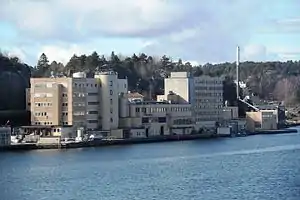Jotun (company)
Jotun is a Norwegian multinational chemicals company dealing mainly in decorative paints and performance coatings (marine, protective and powder coatings).
 | |
| Type | Private |
|---|---|
| Industry | Chemicals |
| Founded | 1926 |
| Founder | Odd Gleditsch |
| Headquarters | Sandefjord, Norway |
Key people | Morten Fon (President and CEO), Odd Gleditsch Jr. (Chairman of the board) |
| Products | Paint |
| Owner | Orkla Group (42.53%) |
Number of employees | 10,000 (2019) |
| Website | www.jotun.com |
As of December 2019, the company has a presence in more than 100 countries around the world, with more than 10,000 employees, 63 companies in 45 countries, and 37 production facilities in 21 countries.

History
Jotun began in the early 1920s as a paint and marine provisions merchant in Sandefjord, Norway. Sandefjord was a popular homeport for whaling ships, which used to get laid up in port every summer for repairs and maintenance. The company's founder, Odd Gleditsch had worked on whaling ships and felt there was a demand for such a provider in the whaling town. During those days, paint stores usually sold pigments, turpentine and linseed oil separately, leaving it to purchasers to buy and mix them.[1] Odd retired from the sea and opened a shop in Sandefjord to sell paints and provisions, but soon felt that a demand existed for ready-made paints. In 1926, he purchased an existing small chemical factory called Jotun. In the early 1930s, the company made its first popular ready-made paint called Arcanol, which was marketed to ship owners and shipyards, a strategy that Jotun continued to invest in. The 1920s and 30s saw a boom in Norwegian shipping, especially in its dry cargo and tanker fleet, and Jotun took advantage of that.
To ensure an adequate stock existed in all principal ports for these Norwegian shipowners, Jotun began stocking paints in North Africa, Europe and the Americas. As the Middle East and Southeast Asian countries developed in the 1950s, Jotun began to market its products to ship suppliers there. The founder's son, Odd Gleditsch Jr., oversaw the company's expansion in the Middle East. Working with the Norwegian export council, he travelled to Libya where Jotun built its first overseas factory in 1962. In 1967, Jotun opened its second international factory in Thailand. which became the base for its operations in Southeast Asia.[2]
In 1982, Jotun opened a trading office in Hong Kong. As China began to open up, Jotun developed a joint venture in Shanghai with the Chinese shipping giant COSCO to provide paints to its shipyards and ships. During that time, Jotun established a separate company called "Jotun Coatings" which focused on the manufacture of paints. In the 1970s, the company began to develop solvent-free powder coatings.[3]
Organization
The Jotun Group has four divisions, with its head office in Sandefjord,[4] Norway.
Jotun and famous landmarks
Jotun has been and is being used on several landmarks.
These include:
- The Eiffel Tower[5][6]
- The Petronas Towers in Kuala Lumpur
- Burj Khalifa in Dubai
- Burj Al Arab in Dubai
- Kingdom Center in Riyadh
- West Tower in Guangzhou
- Canton Tower in Guangzhou
- Esentai Tower in Almaty
- Southern Cross railway station in Melbourne
- Guangzhou TV Tower in Guangzhou
- MS Oasis of the Seas
- Haj Terminal in Saudi Arabia
- Marina Bay Sands in Singapore
- Biomuseo in Panama City
- New Clark City Athletics Stadium in Capas, Philippines.[7]
References
- "The history of Jotun". Jotun paints international. Missing or empty
|url=(help) - "Our history". jotun.com. Jotun official website. Retrieved 23 April 2018.
- Jotun Coating and Inspection Manual, marine coatings. Jotun international.
- Brønnøysund Register Centre. "Company organisation number 923248579" (in Norwegian).
- http://www.jotun.comwww.jotun.cn/www/com/20020113.nsf?OpenDatabase&db=/www/com/20020116.nsf&v=10F6&e=uk&m=932&c=8BD72FFAB6B4B4E0C1257610003B5DA9 Archived 2014-06-22 at Archive.today
- "Reference projects".
- Jose, MJ. "The Athletics Stadium and Aquatics Centre Rise in New Clark City". Philippine Tattler. Retrieved 15 November 2019.
Related reading
External links
| Wikimedia Commons has media related to Jotun (company). |